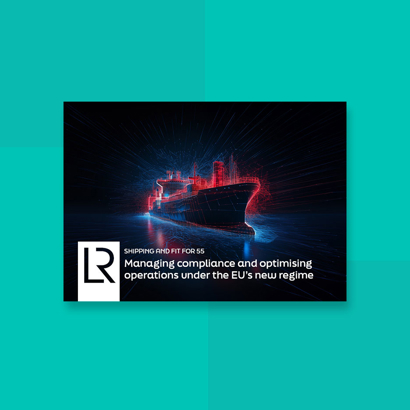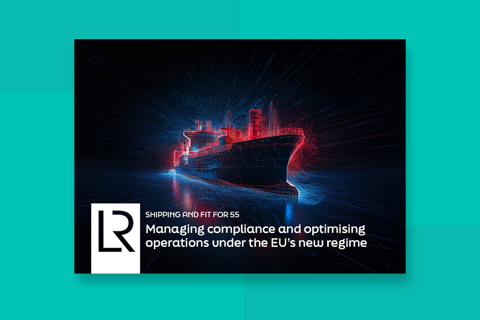The EU ETS, in operation for maritime since 1 January 2024, imposes a wide range of obligations on owners, managers and their customers, and requires proactive risk management. This was the key message from a recent LR webinar – Optimising compliance under the EU's new emissions regime.
The EU ETS will operate in parallel with FuelEU Maritime, due to enter force on 1 January 2025. However, in terms of operation, the two systems will complement each other.
Moderated by David Lloyd, LR’s Programme Director, Energy Transition and featuring insights from Jennifer Riley-James, Lead Regulatory Specialist, Tobias Groeger, Business Development Manager, Maritime Advisory, and Marius Suteu, LR OneOcean – Senior VP Product Performance, the webinar evaluated the challenges and potential opportunities relating to the new regulations. The key message was clear: the new system requires careful management at various levels, from strategic decision-making and emissions prediction through to careful fuel management using routing strategies and other voyage optimisation techniques.
The EU ETS will initially apply to cargo ships and passenger ships of 5,000 gross tons and above. From 2025, offshore ships of 5,000 gross tons and above, as well as offshore and general cargo ships of 400 to 5,000 gross tons will have to report emissions under the monitoring, reporting, verification (MRV) system and will likely fall into scope of ETS in the future. Offshore ships of 5,000 gross tons and above will then fall into scope of ETS from 2027.
EU ETS requires the same party to take responsibility for both MRV and ETS compliance, normally the shipowner, although there is an option to pass responsibility for compliance to the ISM company or Document of Compliance (DOC) holder.
The EU ETS is complex and has introduced an entirely new range of management challenges for those involved in shipping’s value chain. The first point, outlined by Riley-James, is the tight timetable of activity, which means that owners, managers or charterers will have to buy sufficient EU Allowances (EUAs) on the carbon market to cover the emissions from all ships mandated as under their responsibility for MRV and ETS compliance in the previous calendar year, surrendering them annually by each September at the latest.
Failure to surrender sufficient allowances to cover emissions will result in a fine. This will be in addition to the number of EUAs that have to be paid. One EUA is equivalent to one metric tonne of CO2 equivalent.
EUAs must cover 50% of voyages to and from the EEA (EU plus Iceland and Norway) and 100% of voyages within the EEA. The system will be phased in, with the surrender of EUAs covering 40% of verified emissions required in September 2025, 70% in September 2026, and 100% from 2027.
The EU will set a cap on the volumes of emissions allowed across all industrial sectors. Over time the cap will be lowered and the number of EUAs available for purchase reduced. This is part of the EU’s target of reducing greenhouse gas (GHG) emissions by 55% by 2030 compared with 1990, and to achieve net-zero by 2050.
FuelEU Maritime will ensure that shipping companies prioritise improvements in the GHG emissions intensity of the energy they use. FuelEU enters into force on 1 January 2025 with data collection requirements (Monitoring Plans are required from 31 August 2024) and applies generally to ships of above 5000 GT.
FuelEU sets GHG intensity reduction targets for the energy used onboard compared to a 2020 baseline (from MRV data). Annually ships will need to meet the reduction target or be in a compliance surplus in order to comply. Failure to do so will result in a penalty to be paid. This is separate and in addition to any ETS penalty payment and EUA purchase and surrender.
FuelEU will also set onshore power supply requirements from 2030 for container and passenger ships at major Trans-European Transport Network (TEN-T) EU ports. Failure to comply with these requirements will result in additional penalties to be paid (in addition to all ETS penalties, allowance purchase and surrender and FuelEU penalties).The purpose of the regulations is to promote energy efficiency by penalising poor emissions performance, Riley-James said. The system will favour owners using low- or zero-carbon fuels. However, there are various strategies available to minimise the number of EUAs required.
Commercial considerations – ballast hauls
There are also operational issues to consider. Groeger gave the example of a vessel discharging its cargo in Spain and then going to a Gibraltar anchorage for orders. If it was then fixed to load cargo in the US Gulf, for example, the ballast haul from the Gibraltar anchorage across the Atlantic would be considered as part of the ship’s cargo operations and the entire ballast haul would be subject to the 50% emissions calculation.
Just as there are challenges relating to ballast hauls, there could be opportunities too, the experts noted. Depending on the nature of the charter contract, there could be strategic port calls to minimise ETS liabilities. Weather routing and route optimisation, therefore, will be essential tools in helping to ensure that ships remain on their likely emissions performance targets.
When and how many EUAs to buy?
LR OneOcean’s Suteu stressed the need for owners and operators to have tools to monitor the emissions performance of their vessels on a continuous basis. This will be necessary, he said, so that a sufficient number of EUAs can be purchased to cover the likely emissions performance of a ship or fleet. And, since these will be available for purchase in a dynamic market, timing and price could be major considerations.
Transhipment
To avoid the risk of container ships calling at ports close to but still outside the EEA, the regulations exclude certain neighbouring transhipment ports. This means that ships calling at such ports will not be deemed to have broken their voyage from the original port of departure. Therefore the 50% emissions from departure port into the EEA still applies to the full voyage, irrespective of a stop at a named transhipment port.
Only two transhipment ports have been designated so far – Port Said and Tangiers Med. However, Groeger stressed that the EU has said that it will keep this issue under regular review so the current arrangements could change.
Pooling
The FuelEU regulation, which measures emissions on a well-to-tank basis, provides scope for ‘pooling’, the ability to reduce or offset a Fuel EU compliance deficit with one or more over-performing vessels. In one example, the LR experts cited a pool of ten container ships with identical fuel consumption that could be liable for FuelEU penalties of €277 million over a five-year period from 2030. However, if their owner added one single vessel to the pool fuelled by e-methanol, the liability could be reduced to zero.
Pooling is possible between ships within one fleet, and between different fleets. There is significant scope, therefore, for ship managers to provide benefits to their clients: provided they hold the Document of Compliance and manage both MRV and ETS, they are in a position to pool ships within managed fleets and reduce the EUA requirement.








